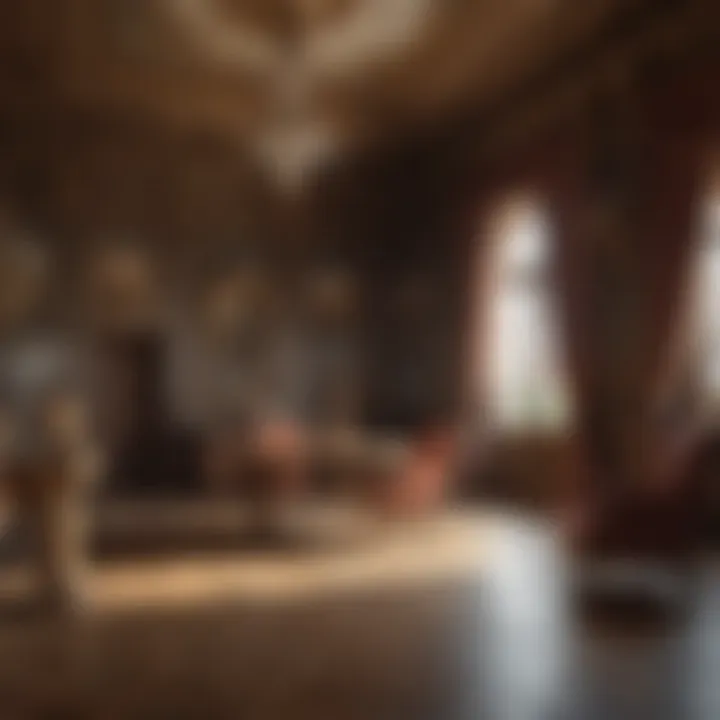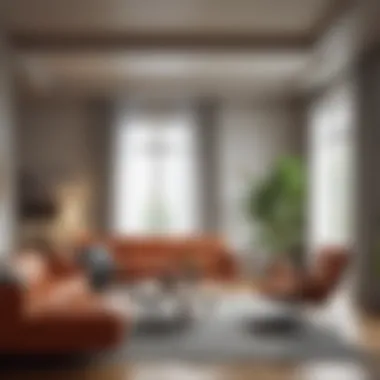The Evolution of Interior Design: A Historical Perspective


Intro
The study of interior design is not merely about aesthetics; it reflects the changing dynamics of culture, technology, and society through ages. Polishing a space is a reflection of values, ambitions, and the lives lived within. History plays a crucial role in understanding the evolution of interior design.
This article aims to dissect the layers of interior design from ancient times to the modern era. Each period unveils a narrative shaped by significant cultural influences, technological advancements, and notable design philosophies.
By tracing the crucial developments in interior design, we can grasp how the past informs current trends and practices in creating functional yet visually appealing spaces.
Research Overview
Summary of Key Findings
Interior design has evolved significantly over the centuries. The exploration of ancient civilizations reveals the importance of function and symbolism. The Medieval period emphasized religious and communal values, while the Renaissance revived classical ideals. The Industrial Revolution introduced mass production and accessibility to design.
More recently, the 20th century brought about a blend of modernism and postmodernism, diversifying styles and philosophies. As we analyze these stages, we notice a consistent interplay of economic factors, social movements, and technological changes that shaped interior design.
Background and Context
Interior design originates from practical needs. Early humans decorated their caves with natural materials, showcasing rudimentary forms of aesthetic intent. As societies progressed, various cultures contributed unique elements to interior design. The Egyptians valued symmetry and order, the Greeks encouraged proportion and balance, and the Chinese emphasized harmony with nature.
In the 19th century, interior design started gaining recognition as a profession, influenced by movements like Arts and Crafts, which advocated for handcrafted simplicity in reaction to industrial abundance. The demand for personal expression in living spaces has intensified, especially in the contemporary backdrop, where design reflects individual identities as much as societal trends.
"Design is a constantly evolving field that mirrors the complexities of humanity."
Understanding these phases provides a foundation for any student, researcher, or professional seeking to engage with modern-day interior design issues. \n \nThe relevance of this exploration lies in recognizing how history informs current trends and methodologies, leading to a more informed practice in today’s design landscape.
Prelude to Interior Design
Interior design is not merely about aesthetics; it significantly influences how we experience spaces. The design of interiors shapes our interactions, activities, and emotions within those environments. Over the years, the evolution of interior design reflects changes in culture, technology, and social habits. Understanding its history allows for a deeper appreciation of contemporary practices and trends. This article aims to explore the various aspects of interior design, highlighting the importance of its historical context.
Definition and Scope
Interior design encompasses the art and science of enhancing the interior of a space to achieve a healthier and more aesthetically pleasing environment. It includes a variety of aspects such as color schemes, furniture choice, spatial arrangements, and decorative elements. Interior design involves both functional planning and personalized decor. The scope can vary from residential homes to commercial establishments, displaying a wide range of styles influenced by time and culture.
Significance of Interior Design
The importance of interior design lies in its ability to create spaces that foster well-being and comfort. Good design is integral in improving productivity in workplaces, enhancing relaxation in homes, and setting the mood in public spaces. An effective interior design approach addresses key human needs, such as safety, convenience, and beauty. Moreover, it reflects the identity and values of communities and individuals.
Interior design also interacts with environmental considerations. Sustainable practices are increasingly at the forefront, shaping modern aesthetics and functionality. This reflects a growing awareness of the environmental impact of design choices. With a commitment to sustainability, interior design can contribute positively to the planet while providing enjoyable spaces for their users.
"Interior design is not just about the visual appeal; it is about the experience created within a space."
In summary, the study of interior design serves as a lens through which we can observe and analyze societal evolution. Recognizing how design has adapted over time influences current practices and anticipates future developments.
Prehistoric Interior Spaces
Prehistoric interior spaces represent the beginning of human design instincts. The importance of this topic lies in understanding the roots of interior design. These early environments showcase how humans adapted to their surroundings and made the first choices about space shaping. The relevance of these spaces cannot be understated as they influenced future design principles based on fundamental needs such as shelter, safety, and functionality. There are several key elements worth exploring.
Cave Dwellings and Early Shelter
Cave dwellings mark one of the earliest forms of human shelter. These spaces provided safety from the elements and predators. People used available natural materials like stone and wood, focusing on durability and protection. The layout was often pragmatic, aimed at serving immediate needs. For instance, the layout of cave paintings reflects early expressions of culture.
In several regions, caves were not just shelters but also communal spaces, indicating early social structures. They symbolize the first attempts at creating a defined living area, setting the stage for more complex designs in the future. The use of space here hints at a need for organization and comfort, serving as a prototype for future interior design philosophies.
Functionality in Early Design
Functionality is a core theme of early design. Prehistoric people prioritized practical aspects over aesthetics. Each design choice was made with intention. For example, the placement of hearths plays a significant role. Hearths were crucial for cooking and warmth, influencing the arrangement of the living space around them. This strategic positioning reflects how functionality drives design decisions.
Furthermore, storage solutions were simple yet effective. Natural depressions or shelves in caves helped in storing food and tools. This ingenuity shows that even in ancient times, the idea of making efficient use of space was vital. The focus on basic functions has echoes in modern design principles, where usability remains a central theme.
Prehistoric interior spaces remind us that the essence of design lies in practicality and human needs.
In summary, examining prehistoric interiors helps us appreciate foundational concepts of interior design. While aesthetic considerations evolved later, the roots of effective design lie in the functionality and environmental harmony established in those early spaces.
Ancient Civilizations and Architecture
Ancient civilizations played a crucial role in the development of interior design. They set the foundational principles that would influence future architectural and design practices. Understanding this era is vital as it reveals how cultural, social, and technological factors converged to shape spaces of dwelling and gathering.
From the structures built by the Egyptians to the intricate designs of Greek and Roman architecture, each civilization contributed unique elements that define our modern understanding of interior spaces. This historical perspective illustrates how the design serves not just aesthetic purposes but also functional and symbolic meanings that persist through time.
Egyptian Contributions
The Egyptians are recognized for their monumental architecture, which is often reminisced through their temples, tombs, and pyramids. These structures showcase their beliefs in the afterlife and the importance of space in religious practices. The internal layouts of these edifices reflected a high degree of organization and purpose.
- Use of Hieroglyphics: Walls often featured elaborate hieroglyphics and paintings, serving dual purposes as decoration and storytelling.
- Natural Lighting and Orientation: Architects considered natural light and the sun's path when designing interiors, creating spaces that were not only functional but also reflective of their beliefs in the divine.
- Material Selection: The use of stone, wood, and papyrus in furnishings illustrates a strong connection to available resources, marrying functionality with the rich symbolism intrinsic to their culture.
In essence, the Egyptians established a precedent for integrating functionality, aesthetic, and spirituality in interior design. Their contributions inform modern practices by emphasizing how elements like light and form can influence space.
Greek and Roman Influences
The Greeks and Romans further advanced architectural design, moving towards more defined methods of spatial layout influenced by emerging philosophies and artistic movements. Their contributions laid the groundwork for significant shifts in the perception of interior spaces.
- Open Spaces and Symmetry: Greek architecture emphasized open-space concepts, often incorporating colonnades that enhanced not only aesthetics but also practical uses for gatherings and civic activities.
- Innovative Use of Materials: Romans popularized the use of concrete, enabling more complex forms of architecture. Their interiors were adorned with mosaics and frescoes, portraying both beauty and functionality.
- Integration of Nature: Gardens and atriums became prominent features in Roman homes, highlighting an early understanding of biophilic design—where spaces are designed to foster a connection with nature.
These influences shaped not just the aesthetics of interiors but also the way space was utilized and experienced. Understanding these elements highlights the enduring relevance of ancient contributions in today’s interior design practices.
"History is not just about the past; it shapes our present and guides our future. The evolution of design principles from ancient times to now creates a rich narrative of continuous innovation in interior spaces."


In summary, examining ancient civilizations offers deep insight into the roots of interior design. Egyptian, Greek, and Roman approaches reflect timeless principles that continue to influence contemporary practices.
Medieval Interior Design
Medieval interior design represents a pivotal phase in the evolution of architectural aesthetics and practical living spaces. It bridges the gap between ancient styles and the burgeoning complexities of later periods. This era, extending roughly from the 5th to the late 15th century, showcases a transition in design approach, influenced heavily by societal changes, religious institutions, and emerging artistic movements.
Gothic Architecture
Gothic architecture marks a significant evolution in the style of buildings during the medieval period. Characterized by pointed arches, ribbed vaults, and flying buttresses, the Gothic style aimed not only for grandeur but also for improved lighting and space utilization. Interiors of Gothic cathedrals often featured soaring ceilings and expansive stained glass windows, which allowed for magnificent light displays that were both functional and symbolic. These elements worked to create an atmosphere conducive to worship and reflection.
The attention to verticality in Gothic design was also significant. It emphasized an upward movement, pointing towards the divine. This notion was crucial, as churches served as centers for religious life and community gatherings. The inclusion of intricate stone carvings and designs conveyed powerful messages of faith and spirituality.
Furthermore, noted structures like the Notre-Dame Cathedral in Paris and Chartres Cathedral exemplify the intricate interplay of architecture and interior design found during this period. The craftsmanship exhibited in these buildings remains influential in contemporary design.
The Role of Color and Textiles
Color and textiles played essential roles in medieval interior design, deeply intertwined with social and cultural practices. The use of vibrant colors, often derived from natural dyes, reflected the social status and affluence of a household. Richly colored fabrics such as silk and velvet were popular among the nobility, used not just for clothing but also for drapery, upholstery, and wall hangings.
Fabrics served both aesthetic and functional purposes, providing warmth and comfort in typically cold stone structures. Tapestries, for instance, were utilized to insulate large hallways and add decorative flair. They depicted historical events, myths, and religious scenes, serving as visual storytelling devices.
"The art of tapestry weaving reached its zenith during the medieval times, with pieces often commissioned by the wealthy to showcase their power and culture."
In addition to textiles, the addition of color through pigments used on walls and woodwork contributed to the overall mood of a space. Deep reds, greens, and blues were common choices, providing a sense of richness and warmth. These elements combined created environments that were more than mere shelters; they were reflections of identity, culture, and artistic expression.
In summary, elements of medieval interior design such as Gothic architecture and the use of colorful textiles highlight a rich interplay between art, functionality, and social context. This period significantly influenced future design movements, setting a foundation for the intricate aesthetics seen in later periods.
Renaissance: A Shift in Style
The Renaissance period marked a significant transition in various fields, including interior design. This era, which spanned approximately from the 14th to the 17th century, is characterized by a renewed interest in classical antiquity. The impact of humanism and the resurgence of art and architecture were instrumental in shaping interior spaces. Designers and architects sought to create environments that reflected beauty, harmony, and proportion.
One of the main elements of this shift was the focus on individualism and the human experience. Designers began to consider how people interact with their spaces. Interiors evolved from merely functional environments to places of comfort and aesthetic pleasure. This shift set the stage for many of the design principles that continue to influence modern interiors today.
Art and Design Intersections
During the Renaissance, the line between art and interior design blurred. Artists like Leonardo da Vinci and Michelangelo did not just create standalone pieces. They also designed frescoes and decor for palaces and churches, integrating their artistic vision into architectural spaces. This collaboration led to more elaborate and decorative interiors.
The use of perspective in painting changed the way spaces were perceived. Interiors often featured wall paintings that created an illusion of depth. This technique transformed flat surfaces into dynamic spaces, enhancing the overall experience of the room. Artists used color and light thoughtfully to evoke emotions and create moods, directly influencing the choice of colors and materials for furnishings and decor.
- Frescoes: These are paintings done on freshly laid wet plaster. They became a popular decorative choice and defined many Renaissance interiors.
- Sculpture: The integration of sculptures within interiors served both decorative and philosophical purposes, often symbolizing ideals of beauty and virtue.
Influence of Humanism
Humanism played a crucial role in redefining interior spaces during the Renaissance. This philosophical movement emphasized the value of human experiences, individualism, and the importance of classical knowledge. As interior designers embraced humanistic principles, they began to design spaces that celebrated the individual.
The interior environment started to reflect comfort, clarity, and order. Public spaces, such as libraries and town halls, featured carefully curated designs that promoted learning and dialogue. Homes were designed to accommodate family life, showcasing a blend of functionality and beauty.
- Proportion and Symmetry: Inspired by classical architecture, designers applied rigorous proportions and symmetry to create visual balance in their interiors.
- Natural Light: Attention to natural light became evident, with large windows and openings designed to invite sunlight into rooms.
In summary, the Renaissance not only marked a pivotal moment in the history of interior design but also set a foundation for future movements. The interplay of art, design principles, and the focus on individual human experience helped shape interiors into meaningful spaces that cater to both aesthetics and functionality.
The Renaissance's rich tapestry of artistic achievement fundamentally altered the perception of space and usability, influencing generations of designers to come.
By understanding these shifts, we can better appreciate how historical context continues to inform contemporary design practices.
Baroque and Rococo: Opulence in Design
The periods of Baroque and Rococo represent significant milestones in the trajectory of interior design, characterized by their emphasis on extravagance and sensory experience. Baroque design emerged in the 17th century and conveyed grandeur through theatrical elements, where interiors were adorned with intricate details to reflect power and opulence. Rococo followed in the 18th century, shifting toward a more playful and ornamental style, focusing on intimacy and elaborate decor. Both movements profoundly influenced how we perceive space and decoration today.
Characteristics of Baroque Interiors
Baroque interiors are easily identifiable due to several key characteristics that define their style:
- Richness in Materials: Use of luxurious materials such as marble, gilded surfaces, and ornate textiles. The intent was to evoke wealth and status.
- Dramatic Use of Light: Baroque design utilized chiaroscuro techniques, where light and shadow created depth and heightened emotional response. Large windows and strategically placed mirrors contributed to this effect.
- Complexity and Grandeur: Interiors often featured exaggerated proportions, dynamic forms, and elaborate decoration, with frescoed ceilings and lavish furniture enhancing the grandeur.
- Theatrical Elements: The inclusion of curving lines and asymmetrical designs reflected a sense of movement, making spaces feel more alive and engaging.
These attributes not only served aesthetic purposes but also communicated the power and influence of the owners of such spaces.
The Rococo Response
In contrast, the Rococo movement offered a response to the formality of Baroque design:
- Playfulness and Lightness: Rococo interiors were characterized by softer, pastel colors and whimsical themes. This approach aimed to create a sense of comfort rather than just display.
- Ornamental Detailing: Rococo emphasized intricate motifs, often inspired by nature, including shells, flowers, and scrolls, which adorned furniture and wall surfaces.
- Intimacy in Space: Where Baroque sought grandiosity, Rococo focused on intimate environments. Rooms became more personalized and inviting, often designed for small gatherings rather than large spectacles.
- Artisan Influence: Craftsmen and artists like Antoine Watteau played crucial roles, as paintings and designs encapsulated the mood of leisure and pleasure that Rococo celebrated.
Baroque and Rococo styles left a lasting imprint on the narrative of interior design. Their juxtaposition not only showcases the evolution of artistry and architectural thought but also enriches current design philosophies. By understanding these movements, we can appreciate the complexities of contemporary interior aesthetics that often draw inspiration from their opulence and refinement.
"Baroque and Rococo are not just styles; they represent cultural narratives that reflect the values and aspirations of their time."
Neoclassicism and the Birth of Modern Design
Philosophical Foundations
Neoclassicism emerged in the mid-18th century as a response to the excesses of Baroque and Rococo styles. It gravitated towards the aesthetic values of ancient Greece and Rome. This movement was driven by a renewed interest in classical philosophy, emphasizing rationality, order, and restrained design. Its impact on interior design was profound, fostering an environment where simplicity and elegance were celebrated.
Philosophically, Neoclassicism invoked ideas from Enlightenment thinkers. Figures such as Jean-Jacques Rousseau and Voltaire questioned prevailing norms, pushing for ideas based on reason and nature. This intellectual backdrop encouraged architects and designers to seek beauty in symmetry and proportion.
An essential aspect of neoclassical thought included the belief that design should reflect moral virtue. Spaces were to embody values such as clarity and harmony. Hence, this emphasis on ethics gave rise to interior spaces that told stories and reflected aspirations of society. Every detail mattered: colors, materials, and layouts were arranged to convey a sense of dignity and respectability.
Emergence of New Materials
During this period, advances in technology and industry began to influence interior design. New materials emerged, greatly transforming how spaces were constructed and decorated. For instance, the introduction of cast-iron allowed for the creation of more intricate designs, facilitating elaborate ornate features in architecture.


Moreover, the use of new textiles opened avenues in soft furnishings. Fabrics like silk and damask became more accessible, allowing a diverse range of patterns and textures to enhance interior spaces. This development expanded the potential for expressing individual style within the neoclassical framework.
Another significant advancement was the production of wallpaper. This innovation provided an alternative to painted surfaces, enabling designers to introduce color and texture more easily. Through these new materials, the essence of interior spaces began to evolve, aligning with the broader principles of Neoclassicism while paving the way for modern design.
"Neoclassicism not only reshaped the aesthetics of interior spaces but also reflected deeper philosophical underpinnings of its time."
This integration of new materials and philosophical ideals ultimately set the stage for modern design, demonstrating how history and innovation continue to interplay in the evolution of interior design.
The Industrial Revolution and its Impact
The Industrial Revolution marks a pivotal point in the history of interior design. It initiated a period characterized by profound changes in production, technology, and societal structures. These changes directly influenced the way spaces were designed and utilized. The shift from craftsman-based production to mass manufacturing opened up numerous possibilities for interior design. As designers began to adopt new methods, the implications stretched far beyond aesthetics; they reshaped functionality and the overall experience within interior spaces.
During this era, the integration of technology led to the creation of more affordable materials and furnishings. This democratization of design meant that a broader segment of society could access quality interiors, which was previously reserved for the wealthy. Understanding the consequences of mass production is essential for grasping how interior design evolved through the 19th and into the 20th centuries.
Mass Production Changes Design
Mass production fundamentally altered the landscape of interior design. Furniture, textiles, and decorative elements that once required extensive manual labor became standardized and widely available. This transformation had several notable consequences:
- Increased Accessibility: With lower production costs, more people could afford stylish furnishings. This led to a variety of styles becoming mainstream, moving beyond elite or niche markets.
- Standardized Design Elements: The introduction of templates allowed for efficiencies in manufacturing that resulted in consistent quality and design. Furniture pieces, for example, began to have uniform appearances, making design principles more consistent across different homes.
- Innovation in Materials: New materials such as plywood and fiberglass emerged, expanding the toolkit available to designers. These materials not only improved durability but also allowed for new forms and shapes in furniture design.
This shift also allowed designers to experiment with mass-produced items. The focus turned towards creating functional yet attractive pieces that could fit into various styles. As a result, the interior design field expanded, accommodating the needs of a changing society.
Shifts in Functionality and Aesthetics
The Industrial Revolution prompted a rethinking of functionality and aesthetics in interior spaces. As homes became more than just shelters, designers began to emphasize convenience and purpose. Some key changes included:
- Functional Layouts: Open floor plans emerged, facilitating social interaction and adaptability in homes. The focus on layout allowed for more effective use of space, changing how people lived within their homes.
- Functional Furnishings: Design shifted toward practicality. Furniture pieces were now designed not only to be visually appealing but also versatile. For instance, multi-use furniture like daybeds or foldable tables became popular choices.
- Aesthetic Diversity: The availability of diverse options in materials and styles led to a richer aesthetic expression. Designers began to incorporate influences from various cultures, leading to eclectic and innovative interior designs.
These shifts laid the groundwork for future design movements. They reflect an ongoing dialogue between form, function, and personal expression in interior spaces. Understanding these developments helps elucidate the complex relationship between historical contexts and contemporary design practices.
"The Industrial Revolution not only changed what was made but how it was made, influencing the very essence of interior spaces."
By examining the impact of the Industrial Revolution, one gains insight into the roots of modern design principles, illustrating the continual interplay between societal changes and interior design evolution.
Modernism: A New Paradigm
Modernism marked a significant shift in the realm of interior design. This movement emerged in the late 19th and early 20th centuries as a response to traditional design practices. Its importance lies in its challenge to historical styles and its embrace of new ideas. This paradigm emphasized functionality and simplicity, rejecting ornate details that had characterized previous eras. The impact of modernism can be seen in both residential and commercial spaces, influencing how they are designed and experienced.
Key Figures in Modern Design
Several influential figures catalyzed the modernist movement in interior design. Notably:
- Le Corbusier: A French architect known for his innovative ideas on space and light. He introduced the concept of "machines for living," advocating for functional design.
- Ludwig Mies van der Rohe: An architect who championed minimalism and the use of industrial materials like steel and glass. His motto, "less is more," became a hallmark of modernism.
- László Moholy-Nagy: A key figure in the Bauhaus, he combined art and technology, focusing on the effects of light and materials in design.
These individuals reshaped the perception of interior spaces, making them more than just aesthetic choices; they became reflections of the society and technology of their time.
Core Principles of Modernism
Modernism rests on several foundational principles that continue to influence design.
- Functionalism: This principle prioritizes utility above all. Spaces are designed to serve specific purposes effectively, often leading to a more open and flexible layout.
- Simplicity: Rejecting complex compositions, modernism favors clean lines and geometric forms. This approach offers a sense of order and calmness to interiors.
- Use of New Materials: Advances in technology during the 20th century allowed designers to utilize materials like steel, concrete, and glass. These materials facilitate more innovative forms and structures.
- Integration with Nature: Many modernist designs focus on blending indoor and outdoor spaces. Large windows and open layouts connect interiors with the environment.
Modernism reshaped interior design, promoting an aesthetic rooted in principles of clarity and function. This movement not only altered visual aspects but also provided a framework that continues to evolve.
Postmodernism and Deconstruction
Postmodernism marks a significant break from the principles of modernism in interior design. It emerged as a reaction against the rigid structures of modernism and embraced a more eclectic approach. This period challenged established norms, questioning the idea that design must adhere to specific movements or styles. By emphasizing a departure from minimalist aesthetics, postmodernism introduced a sense of individualism and self-expression to interior spaces.
One key element of postmodernism is its critique of modernism. Modernism, with its focus on functionality and simplicity, often neglected the emotional aspects of space. Postmodernists argued that design should also reflect cultural contexts and personal narratives. They believed that interiors could inspire feelings and provoke thoughts, thereby moving beyond mere functionality.
Critique of Modernism
The critique of modernism in postmodernism highlights the limitations of a purely functional approach. Modernism often favored clean lines and open spaces, valuing efficiency over emotional resonance. In contrast, postmodern designers sought to integrate ornamentation, historical references, and diverse materials into their work. They believed interior design should tell a story—a narrative of culture, identity, and personal experience. For instance, a living room might balance minimalist furniture with vibrant textiles that reflect the owner's heritage. This blend acknowledges the importance of visual richness and personal expression.
Diversity in Design Approaches
Diversity in design approaches became a hallmark of postmodernism. This period encouraged the exploration of various styles, resulting in an array of influences converging within a single space. Designers began experimenting with color, texture, and form in unexpected ways. Using mixed materials became common, allowing for playful contrasts in interior environments.
- Some notable trends included:
- Eclectic combinations of vintage and contemporary elements.
- The use of irony and humor in design choices.
- Embracing cultural symbols and local traditions in decor.
Postmodernism's influence on contemporary design is significant. It allowed for a more personalized and inclusive approach to interior design, reflecting the diverse cultures and values of today's society. By acknowledging the user's identity and emotional needs, postmodernism created interiors that resonate on a deeper level.
In essence, the legacy of postmodernism in interior design lies in its celebration of diversity, creativity, and the human experience.
Contemporary Trends in Interior Design
Contemporary trends in interior design reflect the current zeitgeist, balancing functionality, aesthetics, and sustainability. These trends are essential as they shape modern living spaces, guiding the principles on which they are designed. By focusing on aspects such as sustainable practices and technological advancements, this section aims to dissect how these key elements interact and their broader implications on the future of living environments.
Sustainable Practices
Sustainability in interior design has become not just a preference but a necessity. As climate change becomes a pressing global issue, designers prioritize eco-friendly materials and energy-efficient solutions. The shift towards sustainable design emphasizes using resources that minimize environmental impact. Examples include materials like bamboo, reclaimed wood, and recycled metal. Designers are also focusing on natural light and ventilation to reduce electrical dependence.
Implementing sustainable practices can provide multiple benefits:
- Reduction in Carbon Footprint: By using sustainable materials and practices, the ecological impact associated with production decreases.
- Healthier Living Environments: Sustainable building materials often have fewer toxic chemicals. This shift leads to better indoor air quality.
- Cost Savings: Energy-efficient spaces often result in lower utility costs over time.
Incorporating elements such as green roofs or living walls not only enhances aesthetics but also promotes biodiversity, creating a harmonious balance between urban living and nature.


Technology and Smart Spaces
The integration of technology in interior design has revolutionized how spaces are utilized and experienced. Smart homes equipped with devices that control lighting, heating, and security have entered the mainstream. This trend reflects a push towards enhancing convenience and energy efficiency, allowing inhabitants to customize their environments more easily.
Key aspects of this trend include:
- Automated Systems: Smart systems can learn routines and adjust settings accordingly. For instance, smart thermostats can optimize energy usage based on daily patterns.
- Interconnectivity: Devices can communicate with each other, offering seamless control. A user can manage multiple aspects of their home environment from a single device, improving user experience.
- Adaptive Design: Spaces can be reconfigured with movable walls and modular furniture, catering to flexible living requirements.
Influence of Cultural Contexts
Cultural contexts have been significant in shaping the landscape of interior design. These elements contribute to the appearance and functionality of spaces, providing insights not only into aesthetic choices but also into the values and beliefs of a society. Understanding how cultural contexts influence design is essential for grasping the evolution of interior spaces through different periods. Each culture brings unique perspectives, preferences, and practices, which help define what is considered acceptable or desirable in interior design.
Global Design Variations
Globally, interior design variations reflect the distinct characteristics of different cultures and traditions. For instance, Japanese design emphasizes minimalism, natural materials, and a deep connection to nature. Traditional Japanese homes, or "Wafu," prioritize functionality and simplicity, showcasing the beauty of natural wood and paper. Conversely, Mediterranean design is vibrant, often utilizing bold colors, intricate tiles, and decorative textiles. These variations serve as a reminder that design is not just a solitary expression; it develops in response to geographical, cultural, and historical contexts.
"The design of space does not merely reflect culture, but actively engages with it, fostering a dialogue between the past and the present."
Regional influences further create a rich tapestry of styles. For instance, Scandinavian design, with its focus on functionality and simplicity, reflects the region's harsh climate and practical needs. On the other hand, Middle Eastern interiors often boast opulence, with intricate patterns, plush fabrics, and an emphasis on hospitality. These global variations not only showcase aesthetic preferences but also communicate the values central to each culture, highlighting how social practices and traditions influence interior environments.
Regional Styles and Their Impact
Regional styles play a crucial role in defining local identity through interior design. Each area has its own materials, climate, and historical influences, which shape design trends uniquely tailored to those contexts.
- Materials: The availability of specific materials can dictate design choices. In areas rich in timber, like the Pacific Northwest of the United States, wood predominates.
- Climate: In tropical regions, open spaces and ventilation are crucial, leading to designs that promote airflow and light.
- Historical Events: Significant cultural moments also shape styles. The aftermath of colonialism, for example, saw the blend of indigenous and colonial styles in places like India, resulting in a unique and rich design heritage.
Knowing the impact of regional styles helps to underscore the interconnectedness of culture and design. The choices made in interior spaces are reflections of the collective narrative of a community, which evolve over time yet remain rooted in tradition. As such, the influence of cultural contexts provides a lens through which contemporary design can be understood and appreciated.
Psychological Aspects of Interior Design
Understanding the psychological aspects of interior design is essential for both practitioners and scholars in the field. Interior design is not just about aesthetics; it is also about creating environments that promote well-being and satisfaction. People spend a significant amount of time in various spaces, including homes, offices, and public areas. Therefore, the impact of design on mood, behavior, and cognition cannot be overstated. Recognizing how design choices resonate with human psychology allows designers to create more effective and engaging spaces.
Color Theory in Design
Color theory plays a pivotal role in interior design. Different colors can evoke various emotional responses. For instance, blue tones frequently provide a sense of calm and tranquility, which is why they are often used in bedrooms. On the other hand, red is energizing and can stimulate conversation, making it a popular choice in dining areas.
Factors to consider with color include:
- Cultural associations: Colors have varied meanings across different cultures. For example, white may symbolize purity in some contexts, while in others it can represent mourning.
- Saturation and brightness: Lighter shades tend to create the illusion of more space, which is beneficial in smaller rooms. Dark colors absorb light, making a space feel cozy yet potentially constrictive.
- Personal preferences: Individual tastes should also guide color selections, since a person's connection to certain colors can enhance comfort and satisfaction in a space.
Designers should carefully select a color palette not just for visual appeal, but also to align with the intended emotional atmosphere of the environment.
Spatial Arrangement and Human Behavior
The arrangement of space significantly influences how people interact with their surroundings. Well-planned layouts can facilitate movement and promote social interaction, while poorly designed spaces can lead to confusion and discomfort. Designing for effective spatial flow involves considering how individuals and groups will navigate a space.
Key aspects include:
- Furniture placement: Arranging furniture in a way that allows easy access and encourages conversation can enhance the functionality of a space. For example, placing seating in a circular arrangement fosters better interaction compared to a linear setup.
- Open vs. closed spaces: Open floor plans create a sense of freedom and inclusiveness but may lack privacy. In contrast, closed spaces provide an atmosphere conducive to focus and intimacy. The choice between these layouts should reflect the intended use of the area.
- Environmental elements: Natural light, views of nature, and the balance of open and enclosed areas can greatly impact mood and productivity. Research shows that access to natural light improves mood and cognitive performance, making it essential in both residential and commercial design.
The Future of Interior Design
The future of interior design is not just a continuation of past movements but also an intriguing amalgamation of technology, consumer behavior, and sustainability. This relevance ensures that designers and clients alike remain informed about emerging trends and innovations. By examining specific elements such as emerging technologies and shifts in consumer preferences, we can understand the profound impact they have on shaping future spaces. The interior design field must adapt, ensuring it remains functional and aesthetically appealing to meet evolving needs.
Emerging Technologies
Emerging technologies are set to revolutionize the way interior spaces are conceived and experienced. Virtual reality (VR) and augmented reality (AR) are powerful tools that allow designers to create immersive environments. These technologies enable clients to visualize changes before actual implementation, reducing misunderstandings and enhancing satisfaction with final outcomes.
Another significant technological influence is the Internet of Things (IoT). Smart homes are becoming more commonplace, integrating devices that manage lighting, temperature, and security through centralized control systems. This trend is making spaces not only more convenient but also more responsive to occupants' needs.
Additionally, advancements in sustainable materials will play a crucial role in future designs. Biodegradable plastics and recycled materials are gaining traction, addressing both environmental concerns and aesthetic preferences. These considerations are reshaping selection processes, emphasizing quality and sustainability.
"The future of interior design is a balance of aesthetic appeal and technological innovation, addressing the needs of outcomes."
Potential Shifts in Consumer Preferences
As society becomes more aware of environmental issues and the impact of design choices, potential shifts in consumer preferences will emerge. Homeowners are increasingly leaning toward sustainable and eco-friendly designs. They now prioritize energy efficiency and natural materials over traditional aesthetics that may not consider ecological impact. This shift is reshaping marketing strategies, with brands focusing on transparency about material sourcing and production processes.
Furthermore, the influence of remote work is prompting a reevaluation of residential spaces. Consumers are seeking designs that support productivity and comfort at home. Dedicated home offices and multifunctional spaces are becoming standard. Designers must reflect these new requirements in their projects, which may also influence layout, color schemes, and furnishing:
- Multifunctional furniture such as foldable desks and convertible sofas
- Home office designs incorporating ergonomic furniture and adequate lighting
A trend towards minimalism is also prevalent. Clients are moving away from clutter towards designs that emphasize simplicity and functional beauty, ensuring spaces remain adaptable and easy to maintain. The approaches to personal space utilization are evolving, prompting designers to think critically about how every element contributes to overall well-being.
In summary, the future of interior design presents exciting possibilities. By staying informed of technological advances and shifting consumer behaviors, professionals can craft spaces that are not only visually appealing but also functional and sustainable.
Epilogue
The article concludes by highlighting the profound significance of understanding the evolution of interior design. This exploration serves as a foundation to grasp how past influences shape contemporary practices. The insights drawn from historical contexts inform not only design aesthetics but also functional considerations in modern spaces.
Summation of Key Insights
The journey through interior design history reveals several key insights:
- Cultural Impact: The styles and methods throughout history are reflections of cultural values and technological advancements. Each period introduces distinct characteristics, which illustrate the priorities of its time.
- Functional vs. Aesthetic: The balance between utility and beauty has always been a pivotal aspect of interior design. Understanding this dynamic helps to navigate current trends and future possibilities.
- Design Philosophy: Key movements, like Modernism and Postmodernism, have questioned norms and encouraged innovation in design thought. This philosophical development persists in today’s discussions around sustainable and smart design.
Relevance of Historical Context in Current Trends
Recognizing the historical context enriches the comprehension of contemporary trends. It is vital for several reasons:
- Influence on Design Preferences: Emotional responses to spaces are often rooted in historical references, shaping what clients and designers gravitate toward.
- Sustainable Practices: Current trends reflecting sustainability stem from past methodologies where resource optimization was essential, even if not labeled as such. Understanding these roots fosters better practices today.
- Cultural Adaptation: As global influences merge, historical contexts serve as guidance in preserving regional design identities while adapting to modern needs. This awareness cultivates a more responsible approach to design.
"The historical evolution of interior design is not merely about trends but a reflection of human expression through space."
In summary, the exploration of interior design history not only showcases its dynamic progression but also underscores its relevance in shaping functional, aesthetic, and socially responsible environments.







